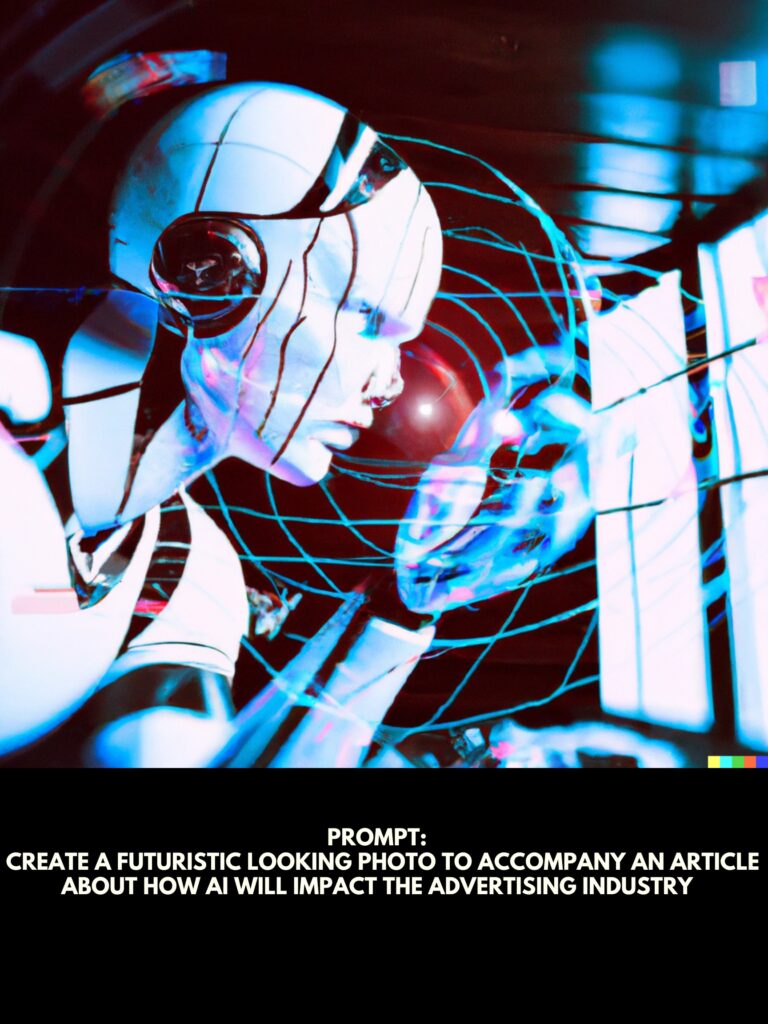AI Goes Viral: How ChatGPT is about to shake up the Marketing, Advertising and PR Industries
December 16, 2022

Note: The header image was made using Open AI’s DALL-E-2 using the prompt “Create digital art of Don Draper from Mad Men meeting Hal from 2001: A Space Odyssey.”
Is AI the way forward?
For the past decade, there has been a lot of hype surrounding the potential of artificial intelligence (AI) to revolutionise advertising and communications. There’s been no shortage of speculation about the jobs that might be lost, the ways AI will outperform humans, and the generally bleak Skynet-like future AI might be advancing us towards. The reality of most of what has come to market for consumers though, from Siri to customer service chatbots, has felt less like the polished 50’s version of the future imagined in the Jetson’s and more like getting stuck at a long line at the DMV run by the characters in Futurama.
Today, we are finally starting to see a fundamental shift in what AI is capable of though and the potential for how it can be integrated into marketing. In just five days, ChatGPT has reached one million users, making it the fastest-growing AI tool of all time. To put this into perspective, it took Twitter twenty-four months, Facebook ten, and Instagram three to reach the million user milestone. This rapid adoption highlights the incredible potential and interest in AI and natural language processing (NLP) and why the marketing and communications industry needs to be closely paying attention.
So what is it?
ChatGPT is designed to generate human-like text responses in a conversation when given a prompt in natural language. It was developed by OpenAI, a leading research institute focused on creating and promoting AI and democratising access to it. It can be used for a variety of applications, including chatbots, automated customer service agents, and language translation systems. It can also be used to generate personalised responses to user input in real-time, making it a powerful tool for natural language understanding and generation.
When it comes to how this could be used by agencies, ChatGPT can assist with everything from the creation of engaging content, such as pitches, articles, and social media posts – and can draft these in natural sounding content in only seconds, to drafting research, analysis and insights on targeted audiences to help optimise campaign performance. The results aren’t always consistent, and it can take on some of these roles better than others, but even in this early beta version you can start to see the enormous potential this might have to save time and resources, allowing communications professionals to focus on more high-level tasks.

Could it displace jobs and make clients more inclined to keep work in house? Maybe, but from the experiments we have been running with it, it seems much more powerful as a tool to augment creativity and human thinking than to replace it.
Rather than displacing agencies, ChatGPT has massive potential to increase the speed of the work agencies do, the number of clients they can work with – and open up time to focus on creativity and strategy in ways they never could before. Tedious tasks like creating multiple drafts of ad copy, editing glitches in code for an app, or summarising a document could be offloaded – while time spent coming up with creative new ways to reach an audience, developing compelling news hooks for a PR pitch or experimenting with entirely new approaches can become the norm.
Before jumping in, there are also some important issues that both clients and agencies will need to be quickly thinking about when it comes to using AI and NLP.
- The technology has leaped far ahead of any ethical framework for using it. Get ready for an arms race with agencies and clients clamouring for access to the best AI engines – think about how and when it would be legitimate to use this technology and what limitations should be placed on it.
- Beware of skewed or inaccurate results. The potential for bias in AI algorithms is enormous – carefully evaluate the AI tools agencies use and ensure transparency in how they use them.
- Context still matters. While the facts might be technically correct, AI systems don’t always understand the context or don’t fully capture the complexity of a situation. The result could be content that damages a brand’s reputation without the right oversight.
To get ahead of these issues, it’s critical to ensure that AI systems are trained on high-quality and reliable data, and that the information they provide is properly validated and verified. Additionally,ensure users are educated about the limitations of AI technology and encourage them to critically evaluate the information it provides.
Despite these challenges, the potential of AI and NLP in the marketing and communications industry is undeniable. Tools like ChatGPT and DALL-E- 2 will make it easier and more efficient for communications professionals to create, manage, and optimise their work. Those that are able to most quickly adapt, and who can see the potential to take advantage of these technologies will thrive in the AI age.
————-
The article above was written by David Brodie, Global Vice President, Innovation & Growth, at global communication agency Citizen Relations, with contributions and augmentation by Open AI’s ChatGPT. Approximately 30% of the content was generated by ChatGPT, showcasing the early potential of this technology in assisting with tasks such as content creation and research analysis. This article has also been illustrated by images using Open AI’s DALL-E-2. This integration of AI and human writing showcases the potential for AI to augment human thinking and increase the efficiency of work in the communications industry.
